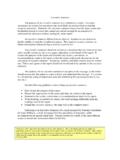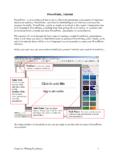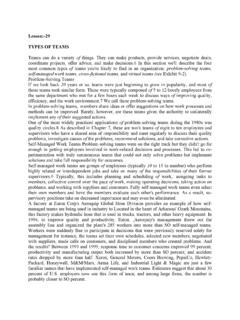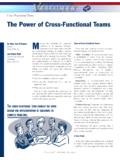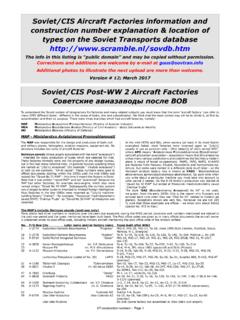Transcription of CHAPTER 14
1 Bateman Snell: Management: The New Competitive Landscape, Sixth EditionIV. Leading: Mobilizing People14. Managing Teams The McGraw Hill Companies, 2003 CHAPTER 14 CHAPTER 14 ManagingTeamsLEARNING OBJECTIVESA fter studying CHAPTER 14, you will teams contribute to yourorganization s makes the new teamenvironment different from the groups become groups sometimes to build an effective to manage your team srelationships with other to manage OUTLINEThe Contributions of TeamsBenefits of GroupsThe New team EnvironmentTypes of TeamsSelf-Managed TeamsHow Groups Become TeamsGroup ActivitiesThe Passage of TimeA Developmental Sequence: From Group to TeamWhy Groups Sometimes FailBuilding Effective TeamsA Performance FocusMotivating TeamworkMember ContributionsNormsRolesCohesivenessBuild ing Cohesiveness and High Performance NormsManaging Lateral RelationshipsManaging OutwardLateral Role RelationshipsIntergroup ConflictManaging ConflictConflict StylesNo one can whistle a symphony.
2 It takes an orchestra toplay it. Halford E. LuccockBateman Snell: Management: The New Competitive Landscape, Sixth EditionIV. Leading: Mobilizing People14. Managing Teams The McGraw Hill Companies, 2003 TWO HIGH-IMPACT TEAMSS etting the Stagecustomer, but the team did want it to be an op-tion if a specific car or truck wasn t already some-where in the channel from factory to the beginning, senior executives often didn treply to Thor s email messages. But thanks to theefforts and talents of Ibsen s team , Jim Schroer,Ford s VP for global marketing, now says theInternet team generated a momentum that wasimpossible to ignore. We have an enormousopportunity as the industry shifts to e-business ..we intend to lead the industry in e-business (p. 124). And, he said, Getting a team to cometogether and execute.
3 Ideas is probably themost important piece of it all. At Toyota, Peter Dames led the electronic-commerce strategy team that wanted to con-vince the rest of the company that those thingshave an impact on everything else our budget,our strategy, our margins. Half the work we dohere is evangelizing (p. 120).Toyota is history-rich, very profitable, andproud. Dames s goal was to show the rest of thecompany that playing by old rules, reveringtradition, and sticking to familiar processes didn tcut team members didn t adhere to theunwritten shirt-and-tie dress code; they worejeans and sneakers. They designed their ownbusiness cards with images of a spaceman and atoy robot very different from Toyota s standardcards. Dames wanted his team to be rebellious,and to be highly visible within team member said, We ve been involvedwith every major Internet initiative at the com-pany, and technology has never been the prob-lem.
4 Another picked up the theme: It s alwaysbeen about getting people to work differentlyand redefining business processes. That s thetoughest nut to crack (p. 136).Source: S. Kirsner, Collision Course, Fast Company,January February 2000, pp. 118 44; A. Layne, Thor Ibsen:How to Create on Internet Time, Fast Company,May The Internet is going to have as much of animpact on the automobile industry as HenryFord s mass-merchandising and production meth-ods did in the 1920s (p. 120), stated Lee Sage,global leader of Ernst & Young s automotive-industry consulting practice. At Ford and Toyota,two work teams are trying to make that Ford, Thor Ibsen led the unit that set outto change the entire company by using the In-ternet to give consumers total choice in findingor creating exactly the vehicle they want.
5 One ofIbsen s teams was theeConsumer Group,which wanted tomake Ford the firstautomaker modeled after Dell s build-to-orderbusiness model. Lead times for autos are toolong to offer build-to-order service for everyThor Ibsen s eConsumerGroup wants to make Fordthe first automaker to offercustomers a build-to-orderservice Snell: Management: The New Competitive Landscape, Sixth EditionIV. Leading: Mobilizing People14. Managing Teams The McGraw Hill Companies, 2003 The Ford and Toyota teams described in Setting the Stage are unique, but in manyways are like most work teams. Such teams are created because of a perceived need oropportunity, have a mission and a task to perform, must meet the expectations ofothers, often face initial skepticism, and have to wrestle with group dynamics. Sometimes they work, and sometimes they don t.
6 At Ford and Toyota, optimism ranhigh as these teams gained momentum, but then the business environment changedas the Internet revealed its fallibility. Who knows how these teams will be doing bythe time you read this? The Ford and Toyota teams may have achieved tremendoussuccess, or may still be working at it but struggling, or may have failed altogether. Theteam members may have used these teams as career launching pads, or may be iden-tified with failures. The goal of this CHAPTER is to help make sure that your work teamssucceed rather than Ford and Toyota teams, and other teams dedicated to other causes,1are trans-forming the ways in which companies do business. Almost all companies now use teamsto produce goods and services, to manage projects, and to make decisions and run the CEO of Texas Instruments, No matter what your business, theseteams are the wave of the future.
7 3 For you, this has two vital implications. First, you willbe working in and perhapsmanaging teams. Second, the abilityto work in and lead teams is valuable to youremployer and important to your is no wonder that team -based approaches to work have generated such appropriately, teams can be powerfully effective as a: Building block for organization structure. Organizations like Semco andKollmorgen, manufacturer of printed circuits and electro-optic devices, arestructured entirely around teams. A team -oriented structure is also in place atKyocera Corporation, which was voted the best-managed company in Japan. Force for productivity. Shenandoah Life Insurance Company credited its newteam organization with a 50 percent increase in the handling of applicationsand customer service requests, with fewer Force for quality. Quality rose 50 percent in a Nortel facility, and FederalExpress reduced billing errors and lost packages by 13 percent.
8 Boeing sengineering teams built its new 777 passenger jet with far fewer designerrors than occurred in earlier programs,5and Boeing received the fastestflight certification ever for a new commercial Force for cost reduction. Honeywell s teams saved over $11 million after reducingproduction times and shipping over 99 percent of orders on claims that it could not have developed the 777 withoutcross-functional teams; it would have been prohibitively Force for speed. 3M, Daimler Chrysler, and many other companies are usingteams to create new products faster. Lenders cut home mortgage approvaltimes from weeks to hours, and life insurance companies cut time to issue newpolicies from six weeks to one Force for change. Some companies have become more entrepreneurial in partthrough the creation of client service KPMG Netherlands, astrategic integration team of 12 partners, with 100 other professionals dividedinto 14 task forces, led strategic and cultural changes by studying future trendsand scenarios, defining core competencies, and dealing with Force for innovation.
9 The auto industry relies on project teams to develop newvehicles, including Ford s great success with its Taurus 3M, workteams turned around one division by tripling the number of new FourLeading: Mobilizing PeopleThe Contributions of TeamsBateman Snell: Management: The New Competitive Landscape, Sixth EditionIV. Leading: Mobilizing People14. Managing Teams The McGraw Hill Companies, 20033M s innovative success stories are numerous and legendary, emerging throughthe use of teams that are small entrepreneurial businesses within the discussing how to develop such high-performance teams, let us talk brieflyabout groups more generally. Groups form because they are useful. In organizations,groups serve numerous functions. Some of these functions benefit the organizationdirectly; others benefit primarily the group s organization benefits because groups have greater total resources(skills, talents,information, energy) than individuals do.
10 Therefore, they can perform jobs that can tbe done by individuals working alone. They also have a greater diversity of resources,which enables groups to perform complex tasks. Groups can aid decision making, asyou learned in CHAPTER 3. When group members exchange knowledge and ideas, it isan important catalyst for creativity and also help socialize newmembers, control individuals behavior, and facilitate organizational performance,innovation, and also provide many benefits for their members. The group is a very usefullearning mechanism. Members learn about the company and themselves, and theyacquire new skills and performance strategies. The group can satisfy important personalneeds, such as affiliation and esteem. Other needs are met as group members receivetangible organizational rewards that they could not have achieved working members can provide one another with feedback; identify opportunities forgrowth and development; and train, coach, and marketing representativecan learn about financial modeling from a colleague on a new product developmentteam, and the financial expert can learn about consumer marketing.




